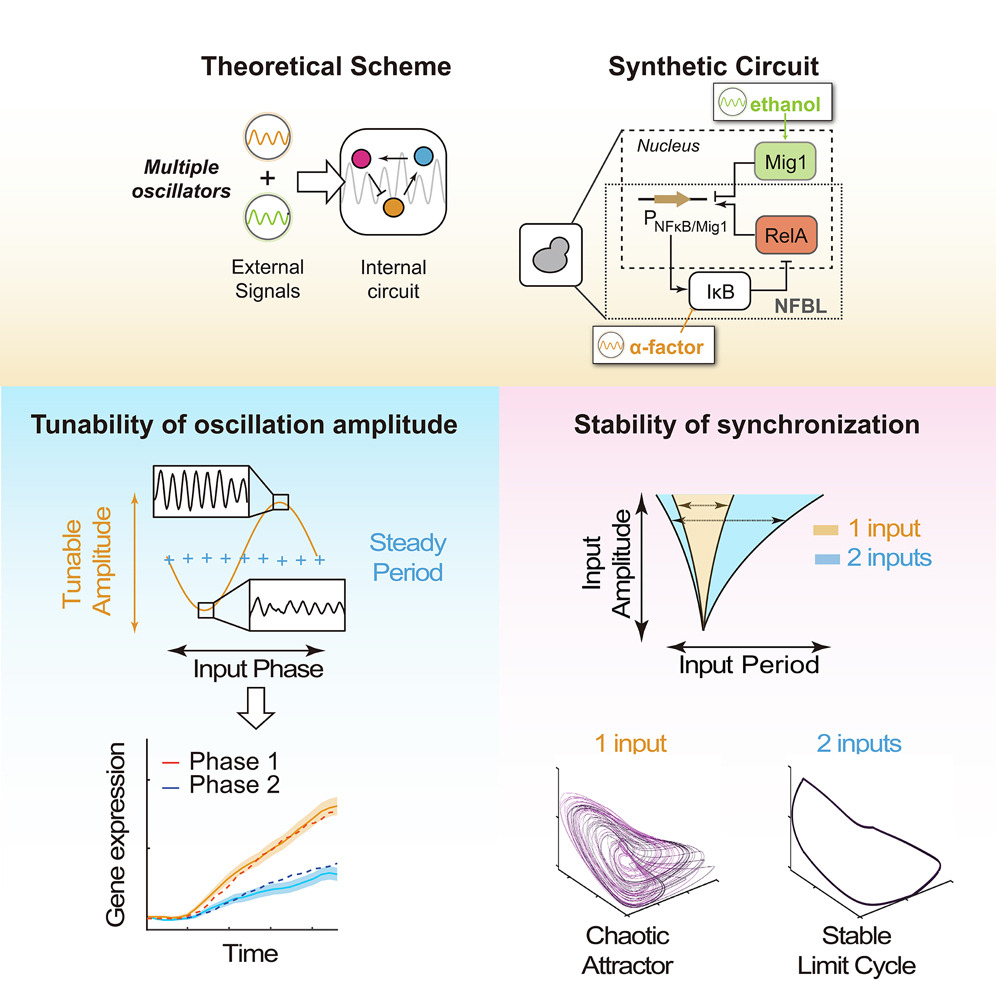
Oscillatory dynamics in fundamental biological processes, such as circadian clocks, segmentation, and transcription factor responses, requires precise quantitative control for proper cell regulation and fate decisions.
Many biological oscillators are influenced by multiple oscillatory signals, and their behavior is understood through the framework of Arnold tongues. However, this approach simplifies the situation to a single external signal and one internal oscillator, which oversimplifies real biological systems. Our understanding of how an oscillator responds to two or more external oscillatory signals is currently insufficient.
Now, a joint research team from the Shenzhen Institute of Advanced Technology (SIAT) of the Chinese Academy of Sciences and the Niels Bohr Institute at the University of Copenhagen has constructed a synthetic oscillatory system in yeast that can respond to dual oscillatory signals. By tightly integrating the experiment and mathematical modeling, the researchers have revealed the cooperative effect of multiple oscillatory signals and the unique phase regulation phenomenon associated with them. These findings suggest a novel path for controlling oscillatory dynamics in both natural and synthetic biological systems.
This work was published in Cell Systems on May 17.
In this study, the researchers modified a previously constructed synthetic oscillator in yeast to acquire a dual-response oscillator. They validated that the system could be synchronized by both periodic α-factor and ethanol, thus representing a tri-coupled oscillatory system. A mathematical model was also derived to fit the parameters and predict outcomes.
Using these methods, the researchers found that two oscillatory signals together could significantly enlarge the entrainment region, increase the ratio of synchronized cells, and delay the onset of chaos. These results suggest that the two oscillatory signals did not linearly combine, but cooperated to stabilize synchronization.
"I had not heard of such a surprising phenomenon before and it is quite interesting that it is unveiled in a biological context. Moreover, evidence for this phenomenon is provided both theoretically and experimentally, using a synthetic circuit, which is an impressive tour de force," said one of the anonymous reviewers of the paper.
Moreover, the researchers discovered that the phase difference between the two external oscillatory signals was a critical parameter for the dynamics of the internal oscillator. By tuning this phase difference, one may finetune the internal oscillation amplitude while the oscillation frequency remains constant. It is further revealed that the optimal phase difference is tightly related to the natural phase difference between the different components of the system in free-oscillating condition.
As a final validation of the phase regulation mechanism, the researchers investigated whether tuning the phase difference between oscillatory signals could affect downstream gene transcription. Despite the existence of noise, they found that gene expression level was indeed significantly affected by phase modulation, which was further linked to different amplitudes of the internal oscillator.
"Our novel synthetic cell signaling system, together with mathematical modeling, serves as a powerful platform to study such complex biological problems," said Prof. WEI Ping, co-corresponding author of the study. "The results presented here broadened our general understanding of biological coupled oscillators and emphasized the importance of a correct time pattern in biological regulation. We hope that these findings may inspire scientists from much more broad disciplines."

Working model outlining how three oscillations interact with each other and produce new dynamic behaviors. Left panel: The amplitude-only modulation of the internal oscillator is enabled by tuning the relative phase of two oscillatory signals. Right panel: The stability of the entrainment is enhanced by additional external oscillations. (Image by WEI Ping)

86-10-68597521 (day)
86-10-68597289 (night)

52 Sanlihe Rd., Xicheng District,
Beijing, China (100864)

